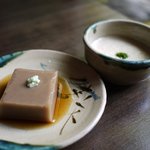
奥丹 清水
okutankiyomizu ◆ おくたん きよみず
3.49
Gion, Kiyomizu-dera, Higashiyama
「Tofu」
--
3,000-3,999円
Opening hours: [Monday-Friday] 11:00-16:30(L.O.16:00) [Saturday, Sunday, Holidays] 11:00-17:30(L.O.17:00)Open on Sundays during the Higashiyama Hanatouro in Kyoto and other extended hours.
Rest time: Thursday
京都府京都市東山区清水3-340
Photos
(20)




















Details
Reservation Info
can be reserved
Payment Method
No credit cards
Electronic money is not accepted
Number of Seats
120 seats
Private Dining Rooms
having
Smoking and Non-Smoking
Smoking restrictions The Law Concerning Measures Against Passive Smoking (Revised Health Promotion Law) has been in effect since April 1, 2020. Please check with the store before visiting as it may differ from the latest information.
Parking
None
Facilities
Calm space, tatami room available
Drink
Sake available, focus on sake
Dishes
Focus on vegetable dishes
Comments
(21)
何が好きって・・
5.00
It is so typically Kyoto that you might pass by without noticing, but the beauty and charm of Kyoto that makes you stop in your tracks and take your breath away. Ninen-zaka, the ancient capital. A grand garden of 600 tsubo with a history of 103 years. The current 16th generation owner. A truly prestigious store with a history of 387 years. Beyond the gate is a corridor of serene silence. Next to the gate, it said "Headquarters of the famous Yudofu Okutan". There was no such connection that would require a reservation, just a chance encounter that led me here. However, I was so drawn in that I couldn't resist and decided to at least say hello and entered through the gate. As I took a step inside, I saw ancient armor and helmets sitting solemnly in a corridor that transcends time. I rang the bell, and a graceful and elegant waitress in an indigo kimono appeared. I hesitantly explained my situation, and she graciously stepped back and offered me a seat. I left my shoes at the entrance and proceeded to the guest room in the back. As I turned several corners of narrow corridors, I was greeted by an incredibly beautiful garden filled with fresh greenery and refreshing green maple leaves that I hesitated to describe in words. The waitress led a few groups of guests to their respective seats, each carefully arranged to suit their view. A reservation tatami room is also available on the second floor. Just like standing in front of a masterpiece in an art museum, I was so captivated by the garden that I forgot to sit down. The waitress softly and kindly approached me and said, "This garden is really beautiful, isn't it? I love it too." I returned to my senses and sat on the cushion, where I was presented with a menu of tofu and explanations. Tofu Menu (excluding tax) <Course> ◯Old-fashioned tofu set ¥4,000 ◯Regular tofu set ¥3,000 ◯Cold tofu Summer limited ¥3,000 <A la carte> ◯Tofu miso ¥300 ◯Premium tofu miso ¥500 ◯Higashiyama's thoughts ¥300 ◯Homemade soy milk with black sugar flavor ¥300 <Drinks> ◯Sake, beer, various soft drinks First, take your time. ◎Cold sake 300ml ¥800 ◎Tofu miso ◎Premium tofu miso And then, ◎Cold tofu (a la carte) ◎Old-fashioned tofu set Finally, ◎Higashiyama's thoughts ◎Homemade soy milk I tried them all. The tofu is made from carefully selected soybeans from various parts of Japan, cultivated without pesticides in Shiga Prefecture. The underground water and natural bitter juice from the northern Biwa region of the same prefecture are homemade. The tofu making process takes place every day in the underground of the garden that spreads before your eyes. ◎Tofu miso. A deep flavor of moromi miso, where the characteristics of tofu and moromi miso intertwine to create a delicious taste. ◎Premium tofu miso. A smooth texture and rich fermented aroma. A masterpiece that has been marinated in moromi miso for over half a year, surpassing the richness of cheese and the umami of sea urchin. Both go very well with sake. ◎Cold tofu. Summer limited silk-filtered tofu. The soft sweetness of the original soybeans is gentle. I would like children with sensitive taste buds who are eating tofu for the first time to taste this delicate deliciousness. They will surely be impressed by how delicious tofu can be. That's the kind of deliciousness I think it is. ◎Old-fashioned tofu set. Stone-milled unpasteurized soybean broth filtered through cotton. Made with only the first dashi of kombu for yudofu. The soft aroma of tofu stands out. There are condiments, but I think it's best to eat it as it is after boiling. Truly delicious, pure tofu from the heart. I hope you can feel it. The set includes: ・Woodland radish ・Sesame tofu ・Shojin tempura ・Yamaimo soup ・Rice can also be served together. Sesame tofu made from white sesame that you wouldn't think was made from sesame. The rich aroma of sesame and the umami that fills the tongue. It was amazingly delicious. ◎Higashiyama's thoughts. A moist and gentle steamed manju with a lot of vegetable-rich okara filling. You can enjoy it freshly steamed. ◎Homemade soy milk with black sugar flavor Finally, soy milk. You can tell from the first sip that this is delicious soy milk. It was delicious.




kjjam
3.00
I went for the second time in three years. The first time was about 7 years ago on a rainy day with a great atmosphere, which left a lasting impression on me, so I decided to go again. The atmosphere was just as good, but it was too hot this time, and the inside of the restaurant was very hot. The air conditioning was old and even with the fan on, the temperature didn't drop at all. The tofu also felt hot, and I was exhausted from the heat by the time I finished eating. I couldn't fully enjoy the atmosphere and taste of the restaurant, so it was very disappointing. If you go to this restaurant, it's recommended to go when the temperature is 25-28°C or lower.

aikoimamura
3.80
This trip was unplanned, so we decided to spontaneously try out this restaurant for lunch. Luckily, we were able to get a table right away, which was a relief on such a hot day. I opted for the summer limited cold tofu lunch set, which included delicious miso-grilled tofu and chilled tofu. The spacious tatami room was very cool and peaceful, making it hard to believe we were in the heart of a tourist area near Kiyomizu-dera. I would love to come back in autumn or winter to try their hot tofu dishes. Just a heads up, they only accept cash here! No credit cards, PayPay, or Suica, so make sure to bring cash with you.




twink818
3.30
There were few staff members and despite available seats, I was needlessly seated next to others. The restaurant has a nice history but the table was wobbly, making it hard to focus on the meal. Also, I wish they accepted card payments. However, the tofu was delicious!


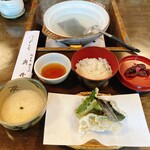
SeMeHi
3.70
I visited the restaurant at the end of May, just before the rainy season started. Despite the humid and hot weather, I was drawn in by the beautiful garden and entrance visible from the gate, and I felt like having a soy milk latte. I didn't have a reservation, but the quiet atmosphere inside was a welcome escape from the bustling world outside. Since I was sweating from the heat, I decided to order a cold soy milk latte and okara steamed bun set, and also felt like having a beer, so I ordered that along with tofu miso. The tofu miso was slightly sweet with a cheese-like richness, making it a great accompaniment to beer or sake. The soy milk latte was not too sweet, made with just soy milk. There were two other groups of foreign visitors besides myself, and I ended up being treated to some delicious tofu by a very beautiful woman sitting next to me. We chatted a bit and I wished I had better English skills to enjoy exploring Kyoto together with her after this.


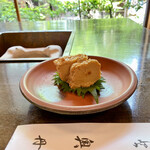
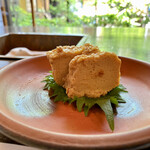
masas123
3.50
I visited on a Friday during cherry blossom season. Although the place opened at 11:00, I arrived at 11:30 and had to wait for about 30 minutes due to a bus tour group. I visited alone and was shown to a private room with a view of the cherry blossoms. I ordered the set menu, and because of the private room, I was able to relax and it was easy for a single person to dine there.




殴られ兎
3.40
Located in Ninenzaka, the long-established tofu hot pot restaurant "Okudan" is a truly authentic establishment founded in 1635. They also have a sister store in Nanzenji. The set meal (¥3000) includes sesame tofu, grated yam, miso-marinated tofu, hot pot tofu, and tempura. The sesame tofu is chewy and rich in sesame flavor. The grated yam is smooth and can be enjoyed on its own. The miso-marinated tofu is firm and flavorful with a hint of sansho pepper. The hot pot tofu is tasty but not as impressive as a previous experience at another tofu restaurant. The tempura, although crispy, has some thick batter parts. Overall, the meal was delicious but did not meet expectations. The service was decent, but I wish they had shown me the menu properly, as I would have liked to try some special dishes. The atmosphere, while renowned, was not as impressive as expected, although it might have been different during the lush green season.

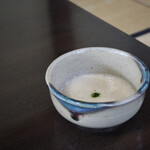


フリーたーアナウンサーモリちゃん
4.50
When it comes to Kyoto, there are various delicious yudofu restaurants with a sense of history, traditional tofu, tasty broth, and a simple taste that goes well with hot sake in the cold Kyoto weather! The course meals are also reasonably priced and recommended! The sesame tofu, miso-marinated tofu, tempura, and grated yam with rice at the end are all delicious! Thank you very much!




もじょ子4420
1.00
When I think of Kyoto, I think of tofu dishes, so I was wandering around looking for a place and came across a restaurant called "Okudan". The staff noticed me looking at the menu outside, but they were too busy chatting with the person at the register. There weren't many empty seats at that time and I was hungry, so I decided to go in and called out to them. They showed me to a table without showing me the menu and took my order right away. Well, I had already decided based on the sign outside, but still... A different staff member was handing out menus to customers, but the one who served me seemed a bit rude. They sat me down with a thud, the sound of serving and clearing dishes was loud, and they seemed a bit strict with the new staff. They also used their foot to open the sliding door when their hands were full, which was a bit off-putting. The service made me feel uncomfortable, so the food also seemed mediocre. The tempura was also not explained, so I was eating two things without knowing what they were. The rice was too wet, which felt strange to me. I might have had too high expectations based on the price and atmosphere. After experiencing the service, I checked the reviews on Tabelog and saw someone else had made similar negative comments about the service, so I felt reassured that my perception wasn't too harsh. It's a shame that a restaurant with such a nice interior and course meals is not making the most of it. I felt it was a shame for Kyoto. Since there are many tourists, I hope the restaurant can provide a better experience for customers. I apologize if my comments are too critical for those who like this restaurant.
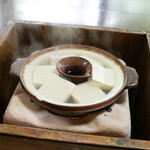



zenryoku_ayapan
3.00
From Keihan Gion-Shijo Station in Kyoto, it's a 17-minute walk to Okutan Kiyomizu, located at 3-340 Kiyomizu, Higashiyama-ku, Kyoto. After visiting Yasaka Shrine, you can explore Kyoto in a classic way. This longstanding tofu restaurant, established in 1635 during the Edo period, offers two course options: one with silk tofu and one with cotton tofu. The "Okutan Kiyomizu Special" for 4,400 yen includes cotton tofu, kinome-tanagaku (a type of tofu dish), tororo soup, sesame tofu, vegetarian tempura, rice, and pickles. The tofu is made from pesticide-free soybeans cultivated in the Hira region of Shiga Prefecture using local groundwater. The "Regular Okimari" for 3,300 yen features silk tofu, kinome-tanagaku, tororo soup, sesame tofu, vegetarian tempura, rice, and pickles. This tofu is made from carefully selected domestic soybeans, offering a smooth and soft texture with a pleasant soybean aroma. The meal is served with bottled oolong tea. Enjoy the historic ambiance of the building and experience high-end tofu cuisine for a true Kyoto experience. #OkutanKiyomizu #Tofu #KyotoCuisine #KyotoLunch #KyotoSightseeing #TofuHotPot #JapaneseFood #KyotoTourism #GionShijo #YasakaShrine #KiyomizuTemple #Higashiyama #KyotoTrip #JapaneseCulture



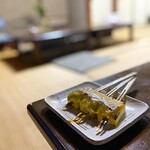
*アナスタシア*
3.60
A traditional Kyoto hot tofu restaurant. We visited the oldest hot tofu restaurant, Okutan, at their Kiyomizu branch on Sannenzaka. Since it was the end of the year, reservations were not available, and we waited for about 30 minutes, but we were able to get in. As we walked through the old Japanese house (full of charm), we saw many private rooms. We enjoyed a relaxing hot tofu meal in a private room with a Kyoto-like garden view. Just being in this setting made the visit worthwhile. The menu only consists of hot tofu, with two options: a set of rich and flavorful traditional tofu dishes for 4000 yen, and a set course for 3000 yen. We ordered one of each and compared them. Both sets included: hot tofu, miso soup with wild vegetables, grated yam, sesame tofu, vegetarian tempura, rice, and pickles. Both of us actually preferred the cheaper tofu set, but overall, it was a great experience and I think it would be suitable for recommending to visitors from afar. The staff were also very kind. Thank you for the meal!




Chocotto
3.60
Today's lunch was at this restaurant. I made a reservation by phone about 2 weeks ago. This restaurant was founded in 1635 as "Oku no Tango-ya". It started as a vegetarian restaurant. It is currently on its 15th generation. The garden is 600 tsubo (around 1,980 square meters) and there is a stream running through it. Popular menu items include: - Assorted old-fashioned tofu for 4,000 yen - Assorted standard dishes for 3,000 yen I ordered a drink, Oolong tea for 200 yen, and the assorted standard dishes. The tofu is made from carefully selected domestic soybeans, giving it a smooth and soft texture with a pleasant soybean aroma. The meal included: - Sesame tofu - Sansho pepper and white miso dengaku - Grated yam soup - Vegetarian tempura - Hot tofu - Rice - Pickles. The hot tofu enjoyed with the splendid view was excellent. The total came to 3,520 yen. Thank you for the meal.




Picoログ
3.80
The flavor of the hot tofu was excellent. It seems like they still make tofu using the same traditional method. This lovely restaurant specializes in hot tofu, and the autumn leaves are beautiful. During the autumn leaf season, you can see the beautiful autumn leaves from the underground room, giving off a serene atmosphere. Thank you for the delicious meal.


jin05422
1.00
When it comes to Kyoto's gourmet scene, "Yudofu" is a classic choice. Developed since the Edo period against the backdrop of abundant soft underground water, Kyoto's tofu cuisine has spread as a Zen temple vegetarian dish. The top choices for traditional Yudofu are the Nanzenji and Kiyomizu-dera areas (such as Okutan, Junsei, Yachiyo, etc.), as well as the Arashiyama area famous for Moritaka tofu. I decided to visit Okutan (near Kiyomizu-dera) to try it out. This establishment, founded in 1635 (Kan'ei 12), is a long-established one. While the food was indeed delicious, being tofu, it lacked a distinct flavor, which I found somewhat underwhelming. The level of customer service was undoubtedly the worst!




nyumata
4.00
On November 12, 2022 (Saturday): "Mukashi Dofu Itto-dori" (tax included 4400 yen) + "Okimari Itto-dori" (3300 yen) When it comes to gourmet in the Kyoto tourism department, "Yudofu" is a classic. Developed as a vegetarian cuisine in Zen temples, the tofu cuisine in Kyoto has flourished against the backdrop of abundant soft underground water, evolving since the Edo period. When thinking of the old-established Yudofu, the first places that come to mind are the Nanzenji and Kiyomizu-dera areas (such as Okutan and Junsei) and the Arashiyama and Sagano areas famous for Morikazu's tofu (such as Nishiyama Sohonten and Takemura). On this day, my daughter and I visited this place for lunch as we were sightseeing at Kiyomizu-dera. The location is about 1.4km east from Keihan Electric Railway "Kiyomizu Gojo Station" and about 1.2km southeast from "Gion Shijo Station". It is located at the point where Ninenzaka and Sannenzaka, leading to Kiyomizu-dera, intersect. The store was founded in 1635. I have visited Okutan at Nanzenji around 2000, but this was my first visit to Okutan Kiyomizu. We arrived at the store around 11:20 am. Reservations are possible, but we visited without a reservation as there are 120 seats in the store. However, as many customers entered the store all at once at the opening time of 11 am, we had to wait on a long bench near the entrance as the second group. After waiting for about 30 minutes, we were guided to the tatami room on the 1st floor and seated. It is a tatami room where you can overlook the 600-tsubo garden with beautiful autumn leaves. I ordered the "Mukashi Dofu Itto-dori" using cotton tofu, and my daughter ordered the "Okimari Itto-dori" using silken tofu. First, tea and hot towels were served, and soon the course dishes were served in order. 1. Sesame Tofu A dish with grated wasabi on top of sesame tofu, soaked in sauce. I enjoyed the pleasantly cool and sticky dish. 2. Tororo Soup This is a dish made by adding dashi to grated yam. It's good to enjoy it as it is, but I waited for a while to pour it over the rice that comes at the end. 3. Kinome Tofu A dish of cotton tofu coated with a sweet white miso sauce with kinome (young leaves of the sansho tree) and grilled. It was served in 3 skewers, so I could savor it slowly. 4. Yudofu Needless to say, this is the main dish of the day. In a pot size 9 or 10, there are 5 pieces each of Okutan's homemade cotton tofu (top) and silken tofu (bottom) made every morning at the tofu factory located underground in the store's garden. The tofu was already cooked to perfection. In the center, there is kombu for the broth. This pot was placed on top of a Hida Konro in the middle of the table. The pot is kept warm with solid fuel inside the Konro. So, let's start eating. I scooped up the tofu with a slotted ladle, placed green onions and sansho pepper on top, then poured a little warm soy sauce broth from the tokkuri (sake bottle) and enjoyed it slowly. The "Mukashi Dofu" made from carefully selected domestic soybeans has a unique rough texture, firm texture, and rich flavor. On the other hand, the silken tofu is smooth, soft, and slightly sweet. Both tofu were delicious, and I was satisfied with the volume as well. 5. Vegetarian Tempura Tempura of 6 ingredients: shiso leaf, seaweed, shishito pepper, shiitake mushroom, grated nagaimo (Chinese yam) dumpling, and pumpkin, dipped in tempura sauce. The tempura of grated nagaimo dumplings, grated with the skin, was particularly fresh and delicious in both texture and flavor. 6. Rice and Pickles I poured the tororo soup and soy sauce broth from the yudofu over the rice as a finishing touch. The pickles were eggplant Shibazuke. While enjoying the conversation with my daughter while looking at the garden from the veranda, we leisurely enjoyed the luxurious yudofu course for about an hour. It was a very satisfying yudofu course.




mok1972
2.50
Guiding a friend from Tokyo around Kyoto. For lunch, we went to Okutan. The wait time was 20-30 minutes, so we checked in. We ordered the standard course (Soft Tofu) for 3,000 yen. It included dishes like Kinome Tadaku, Sesame Tofu, Yudofu, Shojin Tempura, Tororo Soup, Rice, and pickles. We were seated promptly and received the Yudofu within 30 minutes, which we finished eating. However, the Tempura and rice were forgotten and we ended up waiting for about 60 minutes. We were in a hurry, so we complained to the staff. It seemed like they completely forgot about the second part of our meal, which made the enjoyable lunch turn into a disappointing experience.




harut284
2.20
I often use different tofu shops in Kyoto, but I went to Okutan after a long time! On this day, there seemed to be few staff members, so there was a long wait between each dish. A waitress, who seemed like the owner, was rushing around scolding the staff in front of the customers... it made me feel a bit uncomfortable. The yudofu was delicious as always, and the garden had a fantastic view. The miso dengaku was a bit dry (might depend on personal preference). They only accept cash payment, and it took 20 minutes to get change back at the table... It's a famous restaurant, but...




リン1998
3.30
The atmosphere of the shop was nice, so I stopped by after walking around. I waited for 20 minutes after using the buzzer, but no one came. I started to consider going to a different shop, but then a staff member appeared. I ordered the yudofu course and a beer. After 10 minutes of waiting, I still hadn't received my beer, water, or hot towel, so I went to the restroom and asked again when I returned. Eventually, I got the sesame tofu and beer. The sesame tofu was delicious. The interior of the shop was lovely with a view of the courtyard. The tempura was a bit oily and lacked a crispy texture. The staff seemed to be very few, but their service was not bad. It's a good place to visit when you have plenty of time.




しゃけ太
4.00
We enjoyed our meal in a cozy tatami room next to the restaurant's garden. Each dish had a refined taste, not too strong or too bland, allowing us to savor them leisurely. The fried dishes and tofu were particularly delicious. It was a place where we could forget about time and enjoy our meal at a relaxed pace.




BAR店長
5.00
Established for over 350 years, this traditional Kyoto tofu restaurant specializes in yudofu (hot tofu). Located on the way to Kiyomizu Temple, on the scenic Ninen-zaka slope, the restaurant has a calm atmosphere but tends to get crowded. It is recommended to make a reservation if you want to ensure a table. The guest rooms overlook a spacious 600-tatami mat garden, allowing you to enjoy the tranquility of Kyoto and forget about the hustle and bustle outside. The yudofu has a rich tofu flavor, allowing you to savor the true taste of tofu. Sprinkling shichimi togarashi (seven-flavor chili pepper) enhances the flavor and makes it even more delicious. The miso dengaku tofu, with miso and sprinkled with mountain pepper, offers a flavorful taste experience. This restaurant is recommended for those who want to escape the usual hustle and bustle and enjoy a peaceful meal.
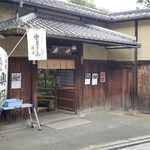



すし和食探究中
3.40
When I woke up, Kyoto was covered in snow, making it a perfect day to enjoy yudofu (hot tofu) and hot sake. The menu offered two types of tofu: the soft "Okimari" for 3000 yen and the firm "Mukashi Nagara" for 4000 yen. Since there were two of us, we ordered one of each. We started with sesame tofu, which had a unique slightly bitter taste. Next came the Kinome Tadadaku tofu, which was simply delicious and perfect with the hot sake. Finally, the main dish arrived - a hot pot containing both types of tofu, served with hot broth, black shichimi pepper, and Kujo green onions. We ended the meal with tempura, mountain yam, and pickled vegetables, feeling completely warmed up and in a great mood.




Email Login